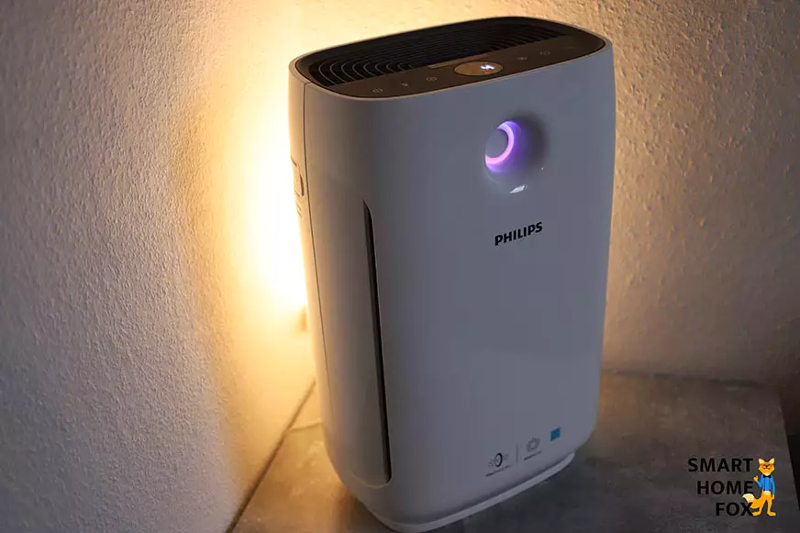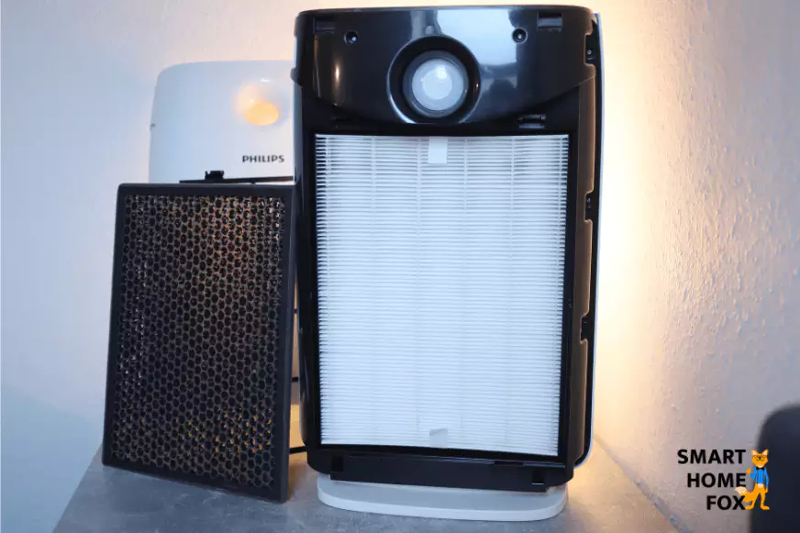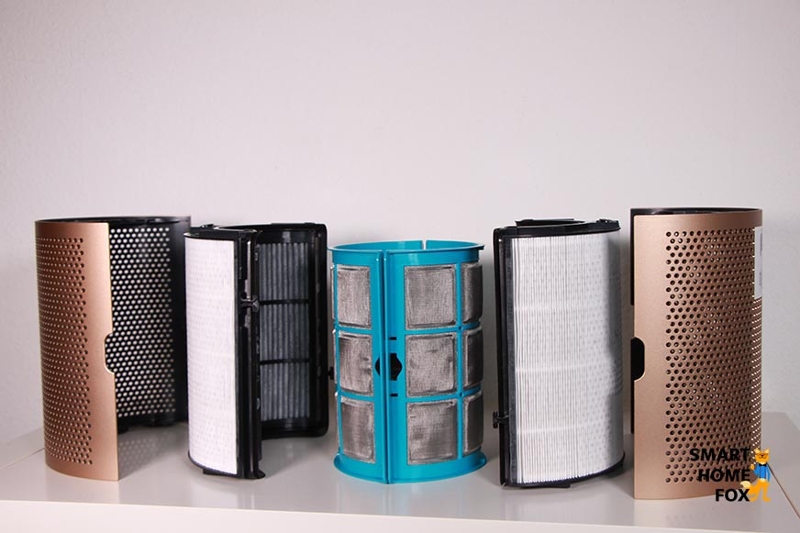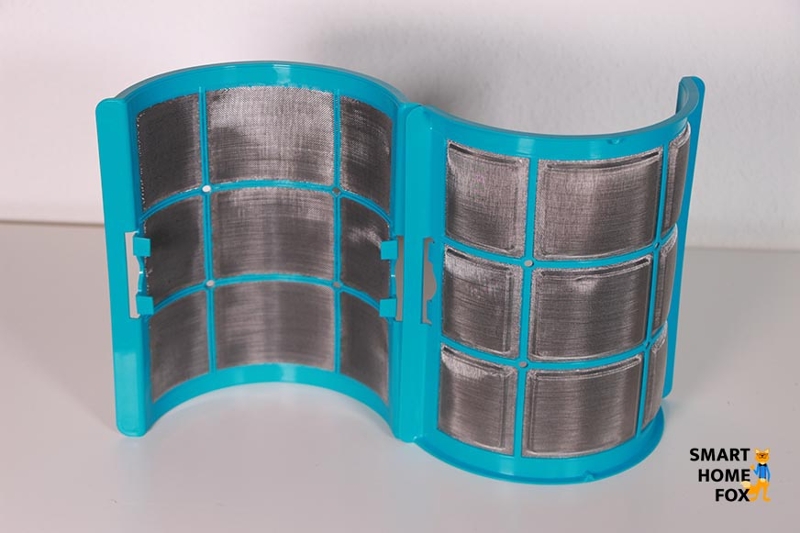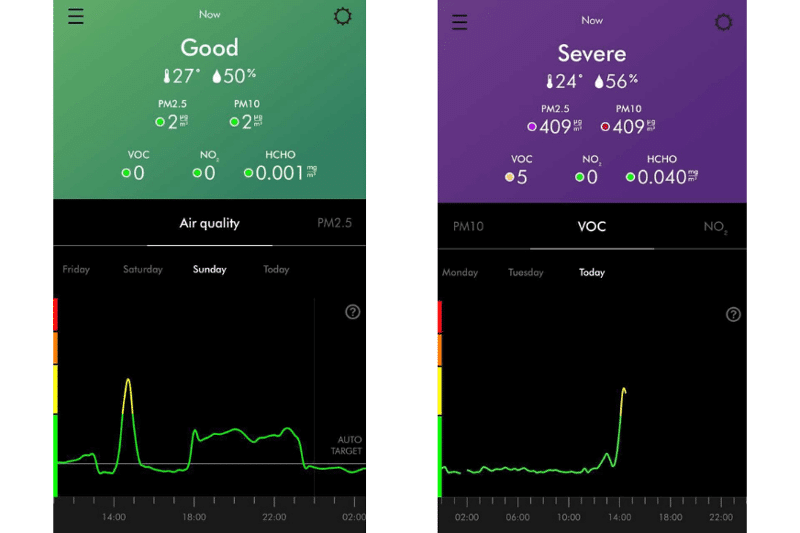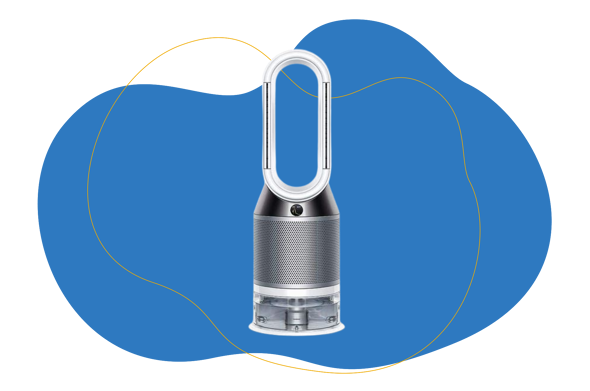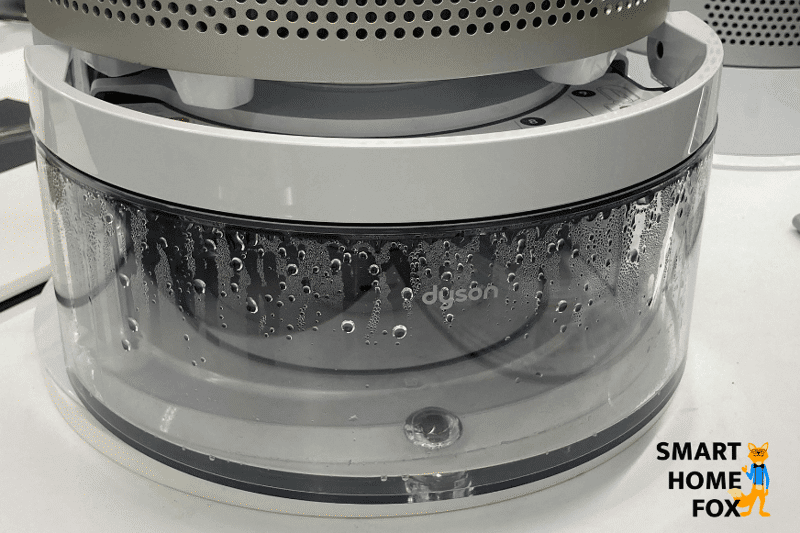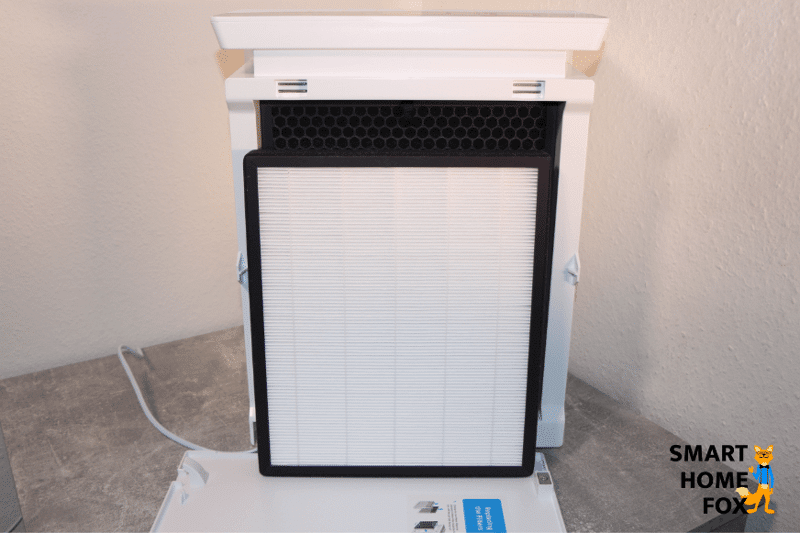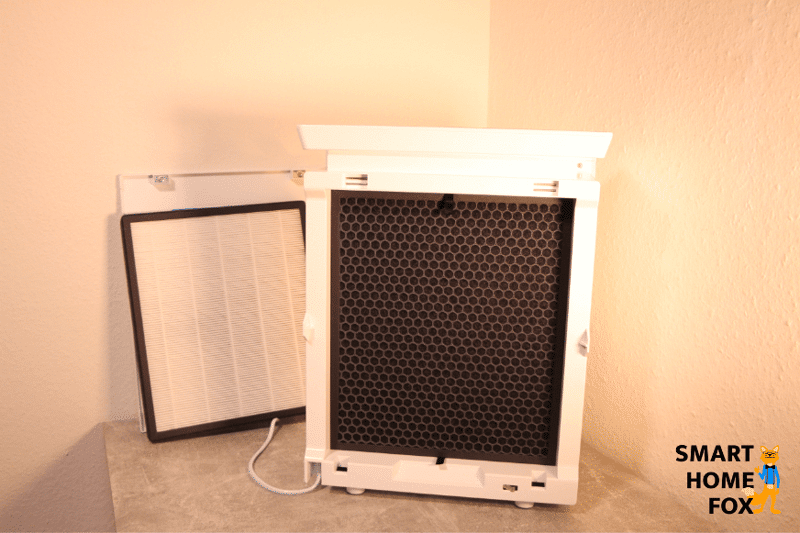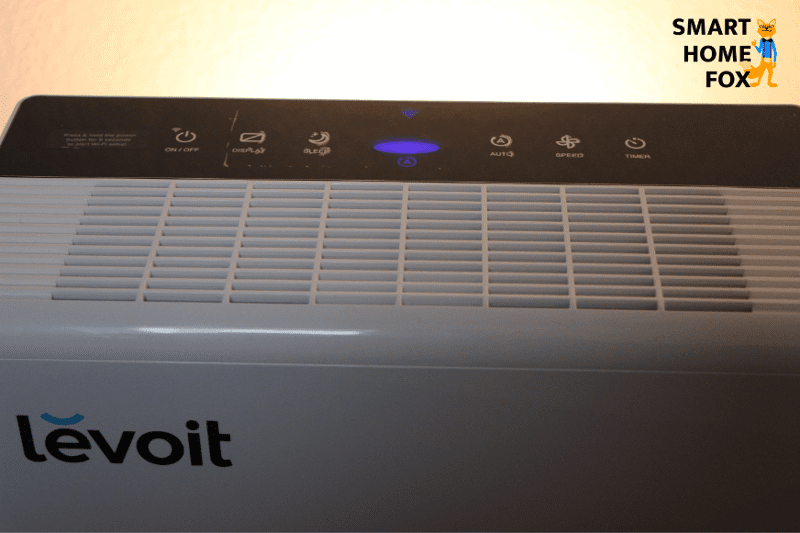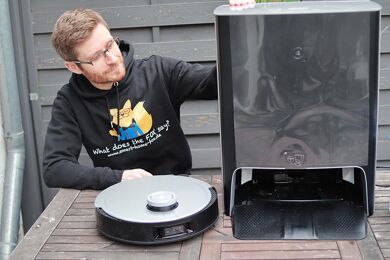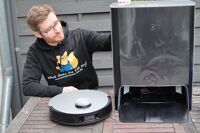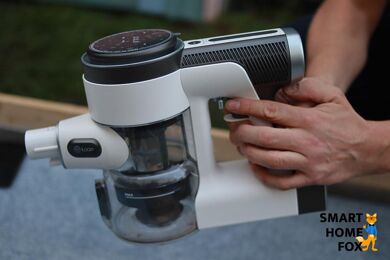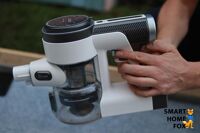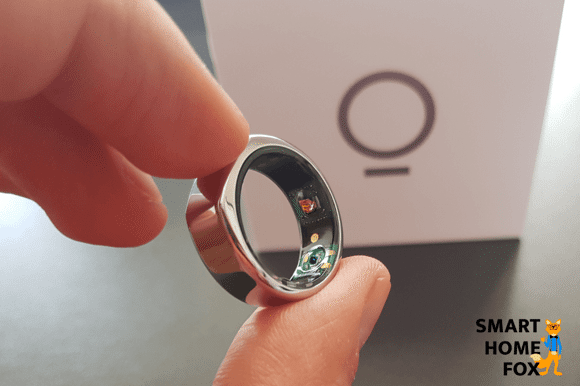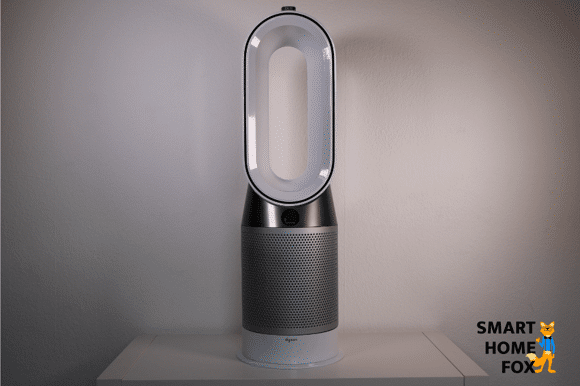Find out more about our favorites now
The AC2889/60 from Philips is an air purifier with a powerful performance. The device monitors air quality with air quality sensors and reacts to air changes in auto mode. The specially developed 'Allergy Mode' is even more sensitive to airborne allergens.
This white, shiny household helper is a visual eye-catcher. The coloured LED ring not only makes the device look modern, but also signals the current air quality at the same time.
Colour ring symbolises your air quality
The colours have the following meanings for the indoor air:
| Colour of the colour ring | Air quality indicator on the display (Indoor Allergen Index IAI) | Significance for general air quality |
| Blue | 1 - 3 | Good |
| Blue - Purple / Magenta | 4 - 6 | Medium |
| Purple | 7 - 9 | Bad |
| Red | 10 - 12 | Very bad |
The air quality indicator lights correspond to the allergen level and is constantly measured by a sensor located on the side of the unit.
Intelligent household helper with automatic modes
The smart household helper independently adjusts its airflow speed to the measured values in one of the 3 automatic speed settings:
- Auto mode (regulates the fan based on the measured air particles)
- Allergen mode (unique mode that is even more sensitive to airborne allergens and allows the fan speed to operate at a higher level)
- Bacteria and virus mode (increases the power level even more to circulate the airflow through the filters faster)
Of course, you can also select the level manually (level 1-3 and Turbo), the Philips air purifier still monitors the indoor air quality, but no longer reacts automatically to changes.
Philips AC2889/60 filtration system
The model is equipped with 3 different filter units:
- 1 prefilter
- 1 NanoProtect HEPA filter
- 1 activated carbon filter
NanoProtect HEPA filter
The HEPA filter captures 99.97% of microscopic and harmful air particles down to a size of 0.003 micrometres in our living room air.
These include various types of contaminants such as viruses (influenza and coronavirus strains), bacteria, VOCs (volatile organic compounds) and dust particles.
The Philips HEPA filter is comparable in efficiency to a standardised H13 class HEPA filter.
Philip’s NanoProtect HEPA filters effectively combat allergens, particles and viruses and are certified by the European Centre for Allergy Research Foundation.
Activated carbon filter
The active carbon filter absorbs air pollutants in gas form.
Continuous operation
Philips carries out stringent service life and durability tests on its air purifiers. During these tests, it was found and validated that the units are designed for continuous operation for at least 3 years.
Advantages
Removes up to 99.97% of contaminants from air |
|
Well suited for middle-sized and larger rooms up to 79 m² |
|
"AeraSense" technology monitors air quality in real time |
|
3 automatic modes (Auto, Allergen and Bacteria mode) |
|
Unique allergen management |
|
H13 HEPA filter |
|
User-friendly app (Clean Home+) |
Disadvantages
Quite heavy at 7.7kg |
|
Relatively loud at higher settings |
|
No manually operable remote control |
The HEPA Purifier Cool Formaldehyde purifies the air while refreshing it with a cool breeze. With 4 sensors, the device checks the quality of the air in real time and automatically reacts to poor air quality. Depending on the power level, the fan can refresh you with up to 290 litres of air per second. 🍃
The beautiful and slim model from Dyson is a state-of-the-art 2-in-1 device. It combines an air purifier and a tower fan in one.
The 2021 flagship is equipped with an efficient filtratoin system consisting of 3 filters:
- HEPA filter (class H13),
- Activated carbon filter and
- a catalytic filter
The HEPA and activated carbon filter are a necessary requirement in an air purifier for allergy sufferers.
Because these two filter units can remove most allergens from the air.
The additional catalytic filter decomposes formaldehyde gas into water and CO₂.
The air purifier knows your air, down to the last detail!
The model is equipped with 4 sensors in the base of the unit. Consequently, the indoor air is continuously monitored and measured for various values:
- The particle sensor measures the particle concentration in your home with a laser (this includes e.g. fine dust and most allergens).
- A gas sensor monitors contamination in gas form.
- The formaldehyde sensor precisely detects formaldehyde in the air.
- Furthermore, the air humidity and the room temperature are recorded with a sensor.
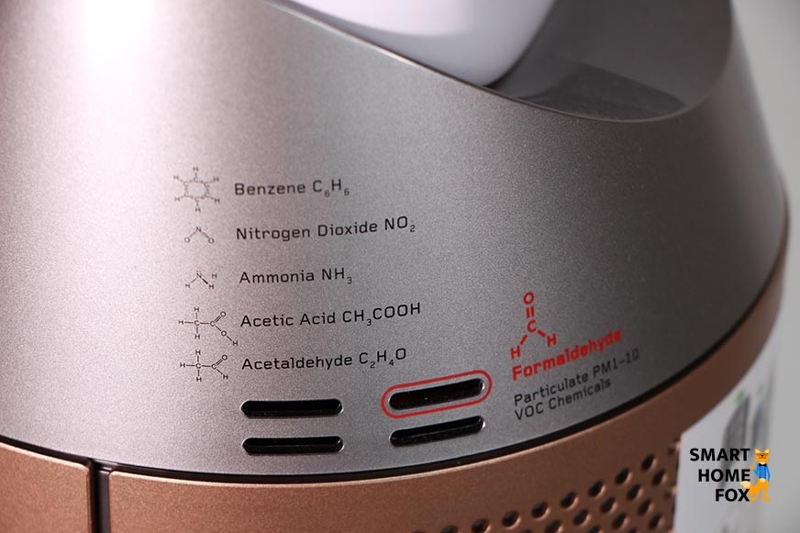 You can view the readings at any time on the display of the air purifier or in the Dyson Link app.
You can view the readings at any time on the display of the air purifier or in the Dyson Link app.
The app will also let you know whenever the indoor air quality in your home deteriorates.
Fan function
The air purifier can only remove allergens that are suspended in the air. However, as soon as they have settled on the floor or furniture, most devices have difficulties with them.
The Dyson Purifier Cool Formaldehyde has a refreshing fan function and a powerful air flow of up to 290 litres per second.
In addition, the model can rotate up to 350° and thus distribute the air better in the room. Here you can see the rotation in action 🎬:
Our verdict
If you're looking for a stylish air purifier for small and medium sized rooms, you'll find it with the HEPA Cool Formaldehyde purifier by Dyson. 🤩
The model very reliably detects and cleans any allergens in the air, and in addition the device acts as a refreshing fan... What more could you want?
Advantages
High airflow rate for cooling fan function |
|
Clean air possible without fan - diffuser mode makes this possible |
|
3 filters to combat air pollution |
|
Various sensors for air monitoring and contamination measurement |
|
Operates quietly on regular settings |
|
Many functions in the app |
|
Exceptional design |
Disadvantages
Not exactly for bargain hunters |
|
Quite loud in higher settings due to the fan |
|
Replacement filters not so affordable |
This air conditioner is first class and innovative. It monitors your air quality and reacts automatically to impurities! By also measuring and automatically regulating humidity, it can prevent and alleviate allergic reactions.
This premium air purifier from Dyson combines the following 3 devices in one:
- Air purifier
- Humidifier and
- Fan.
Due to the variety of functions, the filters, the hygienic air humidification as well as the power, the model is ideally suited for allergy sufferers.
Two highly efficient 180° multifilters
In the Pure Humidify+Cool there are two 180 degree multifilters, which consist of:
- HEPA filter (certified filter class H13)
- Activated carbon filter
 This filter combination is capable of removing 99.95% of airborne particles down to a size of 0.1 microns.
This filter combination is capable of removing 99.95% of airborne particles down to a size of 0.1 microns.
Meanwhile, the activated carbon filter removes gases and unpleasant odours.
As you can see, the air purifier ensures that you can breathe freely 😤.
Humidity creates a healthier indoor climate
Dry skin, irritated mucous membranes and a chesty cough are not uncommon results of excessively dry air.
Fortunately, the Pure Humidify+Cool not only purifies the air, but the device is also an effective and hygienic humidifier at the same time.
The model has a water tank with a capacity of 5 litres.
But even when the tank is empty, the smart household helper continues to clean the air unhindered.
It will only remind you to refill the water tank to be able to use the air humidifier function again.
What else makes the function so special?
Dyson has integrated two systems that ensure that every drop of water that leaves the device is as clean as the air. 🙂
Because the 3-in-1 all-rounder contains:
- Dyson's Ultraviolet Cleanse technology and
- a biostatic evaporator with silver strands.
With these technological aids, 99.9% of bacteria, viruses and germs are removed from the water
The fan - not only pleasant, but also useful for allergy sufferers
The Pure Humidify+Cool's fan features an impressive airflow rate of up to 290 litres of air per second.
The device has no visible rotary blades and instead provides small air slots (oscillators) that rotate at different angles.
If allergens are in the air and settle on the furniture or the floor, the air purifier cannot filter them.
The fan of the Pure Humidify+Cool contributes significantly to raising the air circulation in the room and consequently filtering it more easily....
Our verdict
The Pure Humidify+Cool is an absolute premium air purifier with additional functions such as air humidification and fan.
The device measures and detects air impurities and also keeps the air humidification constant at your desired level. The model regulates the whole process independently and automatically on the basis of your defined settings.
The smart household helper is designed for a small to medium room size. Due to the acceptable air rate, the unit is also suitable for offices or commercial use such as doctors' surgeries.
Advantages
3-in-1 combo device: air purifier, humidifier and fan |
|
Hygienic humidifying with UV light |
|
HEPA H13 and activated charcoal filters |
|
Cooling effect |
|
Powerful air flow at max level |
|
Breeze mode imitates fresh air |
Disadvantages
Quite expensive |
|
Heavy (unsuitable for mobile use) |
The small air purifier from Levoit is an affordable alternative. The model is equipped with an efficient HEPA-H13 filter and modern functions (app). Due to its size and performance, this device is more suitable for the bedroom or home office.
The box-shaped device from Levoit comes equipped with some good technical features, making it a good choice for cheap air purifiers for allergy sufferers.
The LV-PUR131s comes with a separate H13 class HEPA filter unit and an additional activated carbon filter.
There is also a pre-filter on the HEPA filter unit which traps larger particles and protects the HEPA filter from clogging too quickly.
The Levoit model manages to eliminate up to 99.97% of all airborne particles and allergens down to a size of 0.3 microns.
Smart features
The unit uses a sensor to measure the particle content of the air and can independently adjust its fan power to the level of contamination in automatic mode.
You can read the air quality on a small display by means of a coloured indicator.
Here are the meanings of the colours:
| Colour | Air quality | Fan speed in auto mode |
| Blue 🔵 | Very good | Lowest setting / idle mode |
| Green 🟢 | Good | Slow |
| Yellow 🟡 | Medium | Medium |
| Red 🔴 | Bad | High |
In addition, you can also track the values in a clear app display.
The free VeSync app can be connected to the model. Here you get clear data on your indoor air quality and can conveniently control the air purifier remotely.
Our verdict
The Levoit LV-PUR131s is a smart air purifier with efficient filters and therefore well suited for allergy sufferers. We recommend this budget air purifier for small rooms up to a size of 20m².
Advantages
Very quiet |
|
Powerful |
|
Energy-saving |
|
Quite affordable |
|
Cheap replacement filters |
|
H13 HEPA filter |
|
Intuitive control via the app |
Disadvantages
Design takes getting used to |
|
Relatively short filter lifespan |
The comparison of our air purifier favourites for allergy sufferers
| Model | Philips AC2889/60 Series 2000i | Dyson Purifier Cool TP09 | Dyson Pure Humidify+Cool PH01 | Levoit LV-PUR131s |
| HEPA filter H13 | Yes | Yes | Yes | Yes |
| Activated carbon filter | Yes | Yes | Yes | Yes |
| Fan | No | Yes | Yes |
No |
| Humidifier | No | No | Yes |
No |
| Room size | 30 m² | 40 m² | 40 m² | 20 m² |
| App / WiFi | Yes | Yes | Yes | Yes |
| Auto mode | Yes | Yes | Yes | Yes |
| Sleep timer | Yes | Yes | Yes | Yes |
| Remote control | No | Yes | Yes | No |
| Maintenance effort | low | medium | high | low |
| Weight | 7.7 kg | 4,65 kg | 8,29 kg | 5,2 kg |
| Check Amazon | Offer* | Offer* | Offer* | Offer* |
What features should an air purifier for allergies have?
If you suffer from allergic reactions, in addition to keeping your home clean, you should also keep the air indoors free of allergens.
Air purifiers are the perfect household helpers for this purpose. But they should have the following features so that you can breathe freely:
- HEPA filter
- Activated carbon filter
- Easy filter replacement and maintenance
- Sensors for measuring the ambient air
- Smart app for timer overview and planning
Fortunately, air purifiers have evolved tremendously in recent years and many of the modern devices nowadays come with the features mentioned above.
We explain what exactly is important with regard to the points mentioned. 🧐
The all-important HEPA filter
Indoor air contains microscopic particles which can cause allergic reactions when inhaled.
The particles are so small that they are not visible to the naked eye. Some allergens are even smaller than 2.5 microns.
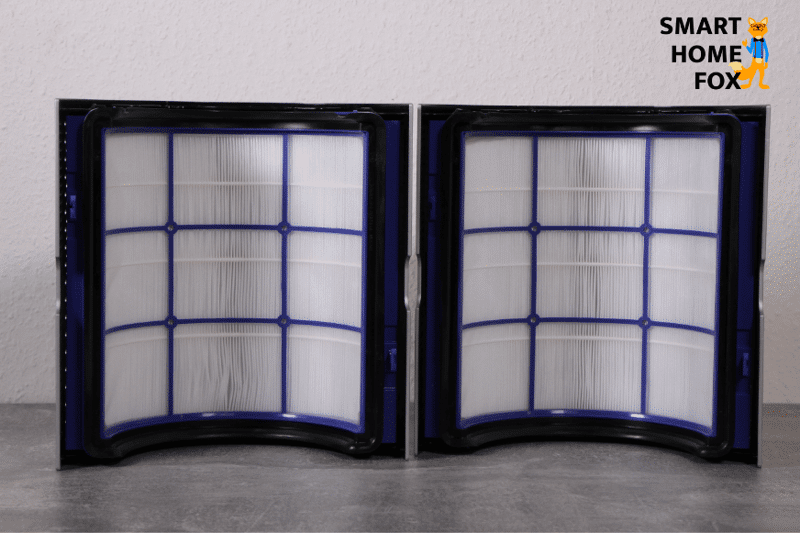
HEPA filters are capable of absorbing and trapping these microscopically small air particles (ultrafine dust, dust particles, pollen, mite droppings, mould spores and animal hair/aerosols) from the air.
This way, allergens are sealed in the HEPA filter and cannot get back into the air.
Activated carbon filter as additional protection
In combination with the HEPA filter, the activated carbon filter provides additional protection against allergens that the HEPA filter cannot capture.
This is because they are present in gaseous form in the air. The activated carbon granules in the filter absorb the pollutants and trap them.

This allows these models to even protect you from cigarette smoke and car exhaust fumes.
Allergy-friendly maintenance
In order for the air purifier to be really efficient in ridding the room of allergens, the device should be in constant operation for long periods of time.
This means that the household helpers, like any other piece of furniture or electrical appliance, will gather some dust and dirt. Filtration systems in particular are a potential danger for allergy sufferers after a while. 🤧
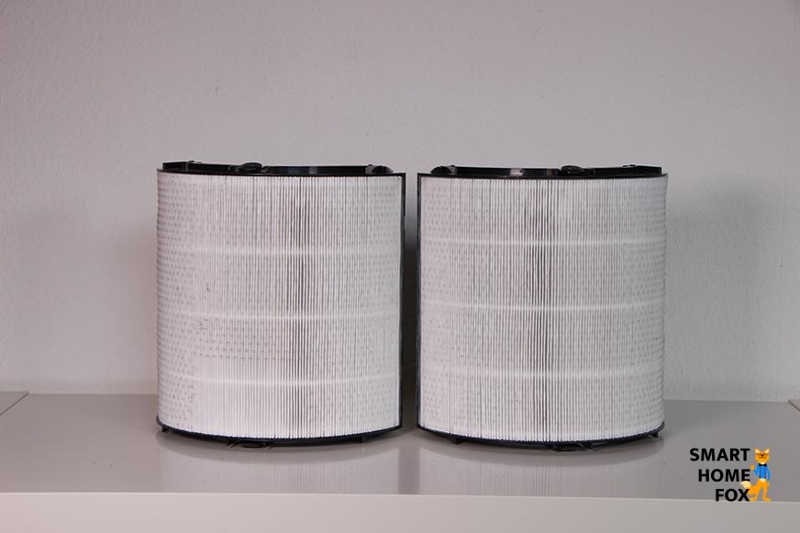
So it’s all the more important that both the maintenance of the appliance and the filter changing system are designed to be as allergy-friendly as possible.
Fortunately, manufacturers have addressed these circumstances and have taken certain precautions such as tabs on the filter units.
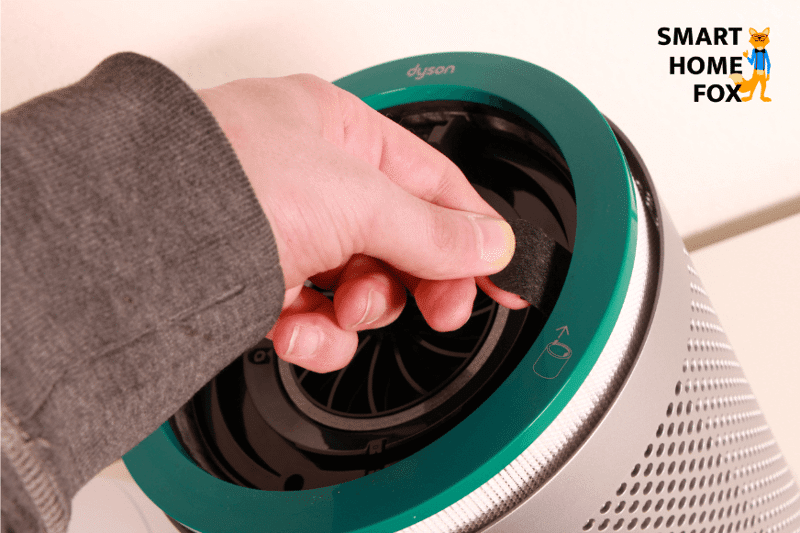
This way, you can avoid coming into direct contact with the dust and allergens sitting on the filter.
The rest of the maintenance is relatively harmless for allergy sufferers, you only have to wipe the model from the outside and keep it clean from the inside after you have removed the filters.
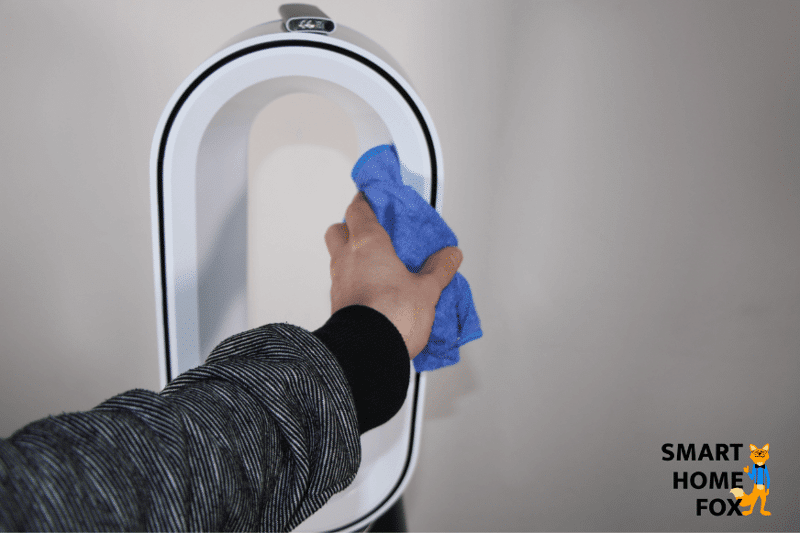

Additional maintenance tips for allergy-sufferers
Tried and tested in pandemic times and always available - the face mask. 😷
Sometimes when you want to clean the inside of the unit or have to change the filter, you will come into contact with a filter at full capacity.
So it’s helpful to just put a face mask on when you’re handling the air purifier.
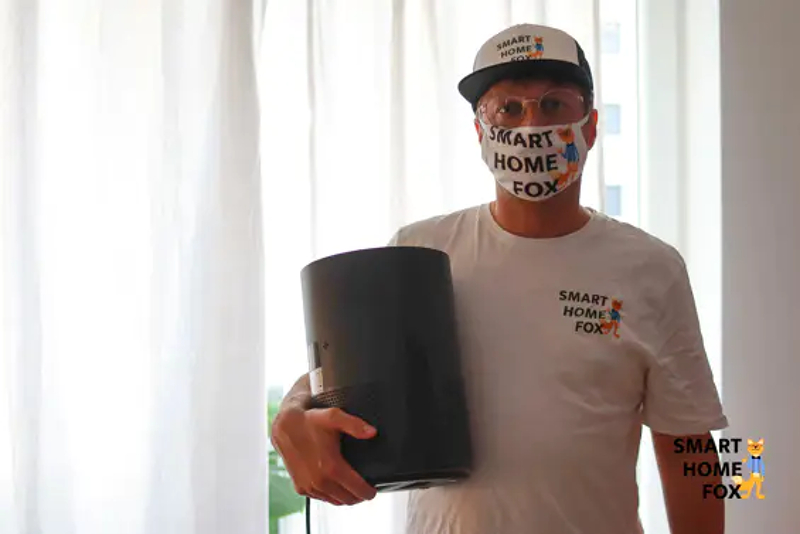
Since 2020, we have plenty of masks lying around and are used to using them.
If you remove the filter units, wearing a mask will add extra protection to your respiratory tract from the allergens in the filter.
Disposable gloves and thorough hand washing
Gloves are another protective option for cleaning. They allow you to safely handle the fully vacuumed filters and dispose of them after the service life of the units has expired.
Make sure to wash your hands thoroughly after cleaning and after touching the filters.
Sensors that measure and analyse air pollution
Modern air purifiers are equipped with different sensors to measure and detect the particle content of the air as well as air pollution.
Some of the devices recognise your ambient air down to the last detail and are therefore true air experts in your living room. 🤓

Sensors on premium models even detect what kind of contamination is involved.
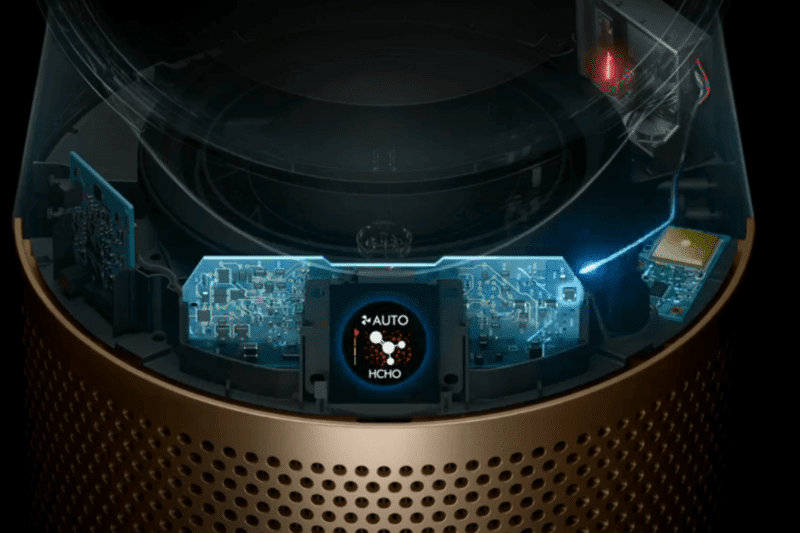
Automatic mode on air purifiers
The models that are equipped with sensors almost all have an automatic mode integrated.
In automatic mode, the unit reacts automatically to the air pollution in your home.
Consequently, the smart household helper measures the air pollution and adjusts its performance according to the measured values.
Air treatment with smart app functions
Most air purifier manufacturers have proprietary apps.
The apps offer a variety of information. For example, you can:
- Find detailed information on your air quality 💡
- Get facts and figures on the air purifier and filter life 🧐
- Control the unit itself 🕹
An additional practical function is the programming of operating schedules. This way you can fully adjust the air purifier to the daily pollen count.
Then you can programme the smart household helper to switch on by itself at a desired time, operate at the desired level for a period of time and go back into standby mode by itself once the programme ends.

Find the right unit for your room
Another important factor is to adjust the filter and air purifier performance to the desired room size.
This is because a low-performance air filter is less effective in large rooms than in small ones.
How do I find the right size HEPA air purifier for my room?
Most brands specify a room size for their models. Unfortunately, this information cannot be relied on 100% because it is based on the manufacturer's own tests.
In addition, there is the CADR (Clean Air Delivery Rate) specification.
You can use these two values as a guide to find the right household helper for combating allergens for your room size.
Should an air purifier run continuously?
Basically, an air purifier is effective when it is in constant operation for long periods of time. Only then can it filter allergens (house dust, pollen, dust mites) efficiently.
So it’s all the more important that the air filter runs at a high performance level during periods of high pollen counts.
In the city, exposure to pollen tends to be highest in the evening. In the countryside, on the other hand, the most active time is in the morning.
As explained above, you can optimally schedule the operating times of the unit with timers. As a result, the unit does not have to work around the clock when you are not in the room.
How much electricity does an air purifier consume?
Also important to note is that you don't have to worry about the electricity costs of these devices. In our tests, we examined the power consumption of some of the devices and, in our experience, the devices generally don’t consume too much power.
We found that the smart household helpers have a comparable energy requirement to a smaller laptop.
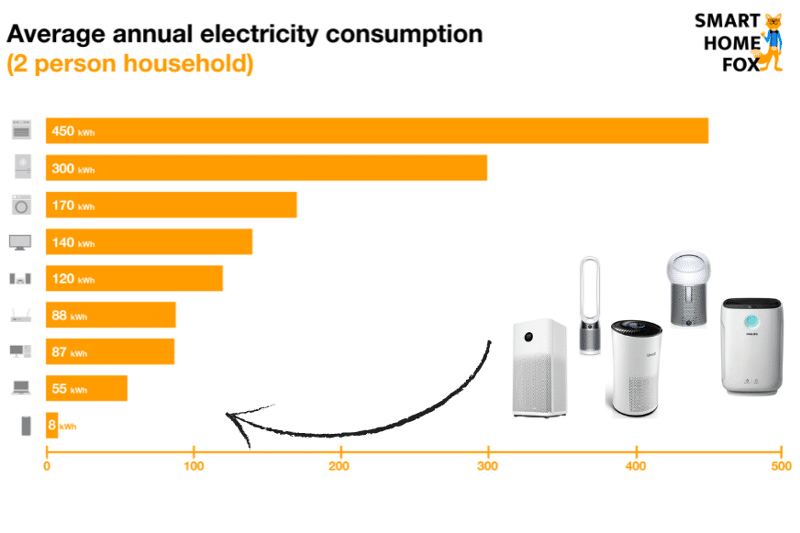
How loud are air purifiers?
We tested several air purifiers and let them operate at different levels for longer periods of time.
In our experience, the devices are pretty quiet household helpers.
Basically:
- Low fan speed ▶ Low noise level
- Increased fan power ▶ Increased volume
However, the models work relatively quietly (approx. 50 dB) even at high/maximum power. Thus, even at full power, the volume is comparable to rain or a conversation.

You don't hear the fan (motor) itself, but rather the air being forced out of the vents with increased force.
Accordingly, most air purifiers make a noise similar to the fan of a powerful computer or laptop.
How well do air filters combat house dust and fine dust?
As already mentioned, air purifiers are equipped with the finest filters. Due to this, the devices can remove house dust and even microscopic fine dust from the air. ✅
However, the household helpers cannot capture the dust once it has settled on the floor and furniture. ❌
Models with a good CADR rating increase the air circulation in the room and can help remove house dust and fine dust before it settles and gathers. 💨
We have some great alternatives that will help you. ⏬
What alternatives to air purifiers are there for tackling allergens?
Air filters are great "anti-allergen helpers", but unfortunately they can't do everything...
...that's why we have tested other alternatives that can be helpful for allergy sufferers and you can read our results on the most successful household helpers in these two articles 🧐:
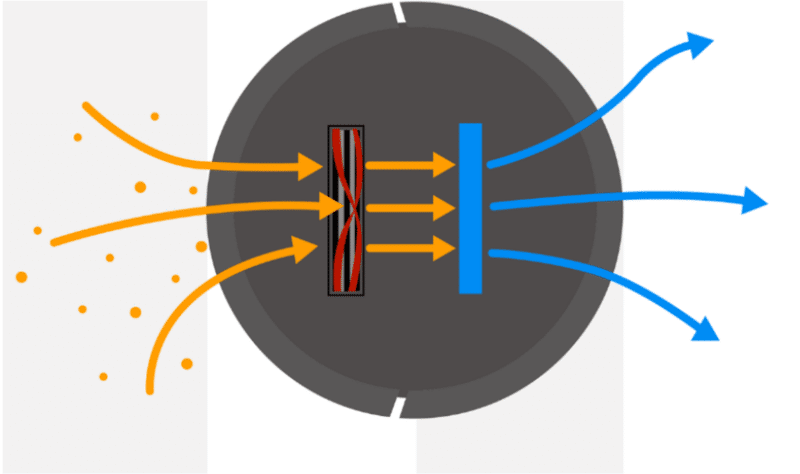

These two devices will help your air purifier fight allergens.
Which? Best Buys for air purifiers in the UK
The independent UK consumer organisation Which? has tested more than 60 different air purifiers.
They score models out of 100%, with marks given for categories such as:
- Dust/smoke/pollen removal
- Quietness
- Ease of use
- Smart features
The Electriq EAP500HC emerged as the winner overall with a score of 85. It did well in most of the categories listed above, with marks deducted for its heavy weight and volume on the highest setting. 🏆
Coming in at second place is the Blueair Classic 605, which received similar praises and criticisms to the test winner.
When it came to reviewing our own test winner, Which? awarded the Philips 2000i AC2889/10 76%, calling it a “brilliant air purifier” but criticising its filtration system for its difficulty in replacing and removing filters.
The unit scored five stars in dust removal, smoke removal and energy efficiency, with 4 stars given for pollen removal.
Are air purifiers for allergy sufferers covered by health insurance in the UK?
Effective premium air purifiers can be expensive. So we recommend asking your health insurance company whether subsidies - or even cost absorption - are possible.
In order for the costs to be covered by a health insurance company, your allergy must be confirmed/attested by a family doctor or allergist.
Then you can apply for reimbursement before the purchase. Approval depends on the health insurance company and the person in charge.
Nevertheless, it’s worth staying persistent even in the case of a rejection and to file an objection.

Do air purifiers work for allergies? Our conclusion
For people with pet allergies, dust allergies or hay fever, allergen-free air is a must and makes everyday life much easier.
Your indoor air is effectively filtered by air purifiers and monitored for contamination. Modern devices are smart and mostly work fully automatically.
The best air purifiers should have the following characteristics to properly fight allergens:
- HEPA filter (class H13)
- Activated carbon filter
- Smart timer function and app
- High fan power (air should be able to be filtered up to 5 times within 1 hour)
Then the exposure to allergens in your home will decrease significantly.
Consequently, you can say goodbye to watery eyes, runny nose and sneezing fits and can breathe freely in your home and enjoy the allergen-free air. 😌
Table of Content
The best air purifiers to keep you sniffle-free at home
Find out more about our favorites now
The comparison of our air purifier favourites for allergy sufferers
What features should an air purifier for allergies have?
Activated carbon filter as additional protection
Sensors that measure and analyse air pollution
Air treatment with smart app functions
Find the right unit for your room
Should an air purifier run continuously?
How well do air filters combat house dust and fine dust?
What alternatives to air purifiers are there for tackling allergens?
Which? Best Buys for air purifiers in the UK
Are air purifiers for allergy sufferers covered by health insurance in the UK?













